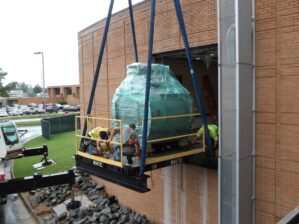
The UAMS Psychiatric Research Institute’s Helen L. Porter and James T. Dyke Brain Imaging Research Center has been a leader in the field of clinical neuroscience since it opened in 2009 but a recent major upgrade in its core technology will help the research group, in the words of its director, take “a diversity of approaches to power a better understanding of the brain mechanisms of human mental health and illness.”
To maintain its cutting-edge research efforts, the Brain Imaging Research Center (BIRC) replaced its Philips 3T Achieva magnetic resonance imaging (MRI) scanner on Sept. 13 with a new Siemens 3T Prisma MRI scanner, capable of imaging brain function and structure with improved spatial and temporal resolution. The new scanner is earmarked for research purposes only and is the first of its kind in Arkansas.
The scanner will enable the Brain Imaging Research Center’s extramurally funded research initiatives, which include modeling long-term consequences of childhood maltreatment, and now the COVID-19 pandemic, on brain function and cognition; using rapid “real-time” brain imaging to study root causes of mood and personality disorders; and understanding changes in brain function which promote recovery from opioid addiction.
“The new MRI system is a key part of a strategic plan,” according to Clint Kilts, Ph.D., the center’s director. “It will be used to explore new dimensions of the addiction process and how we treat it, new dimensions of child health and well-being, which I think is particularly relevant to the state of Arkansas, and new dimensions in how the brain processes affect or emotion. It will also open up a much expanded involvement of other UAMS investigators and other investigators in the state doing brain imaging science.”
The BIRC continues the research commitment to improve the mental and behavioral health of Arkansans and is the product of a generous gift from Helen Porter and her late husband, James Dyke. With this new MRI scanner fully functioning, 2022 brings the beginning of many new research projects for the BIRC and other UAMS and UA system faculty, as well as the ability to support new areas of brain imaging be new faculty.
